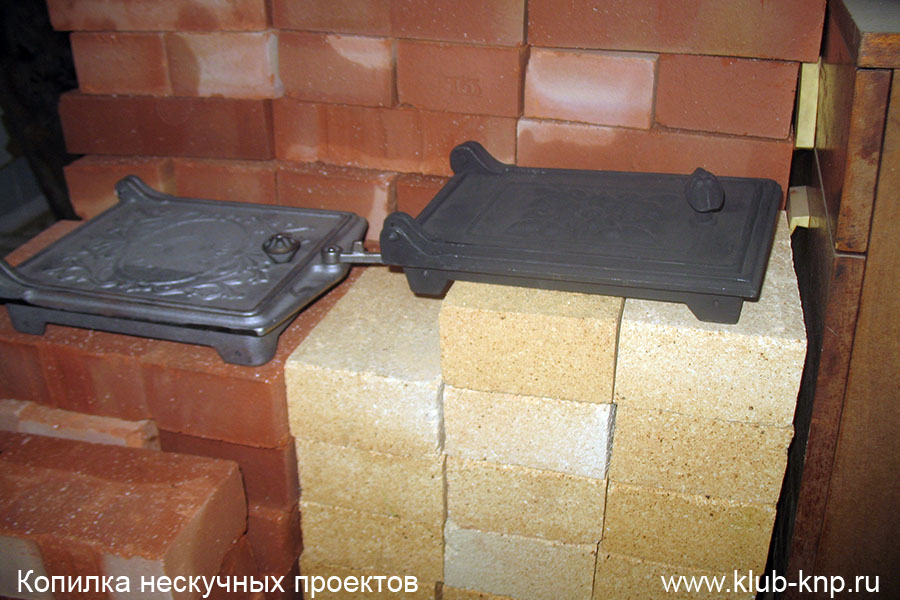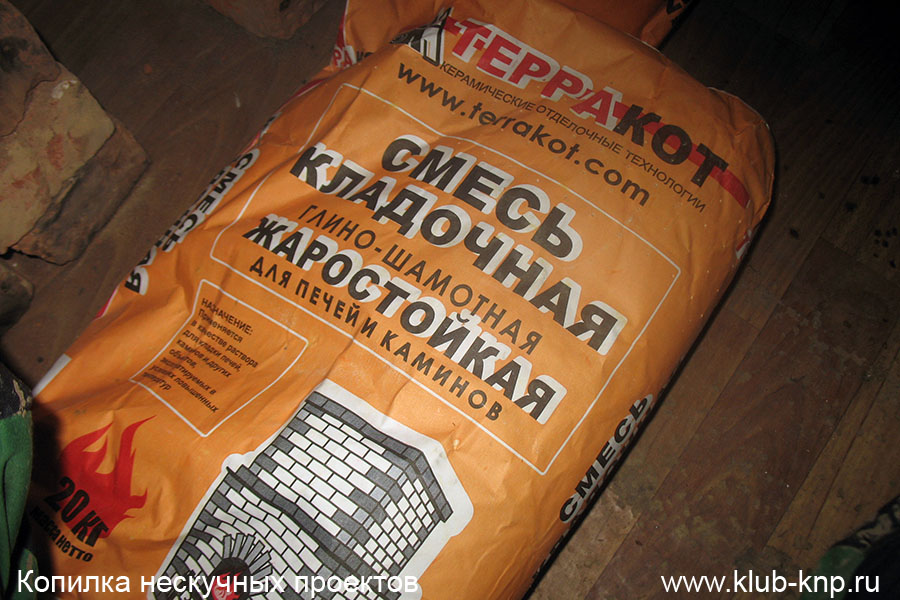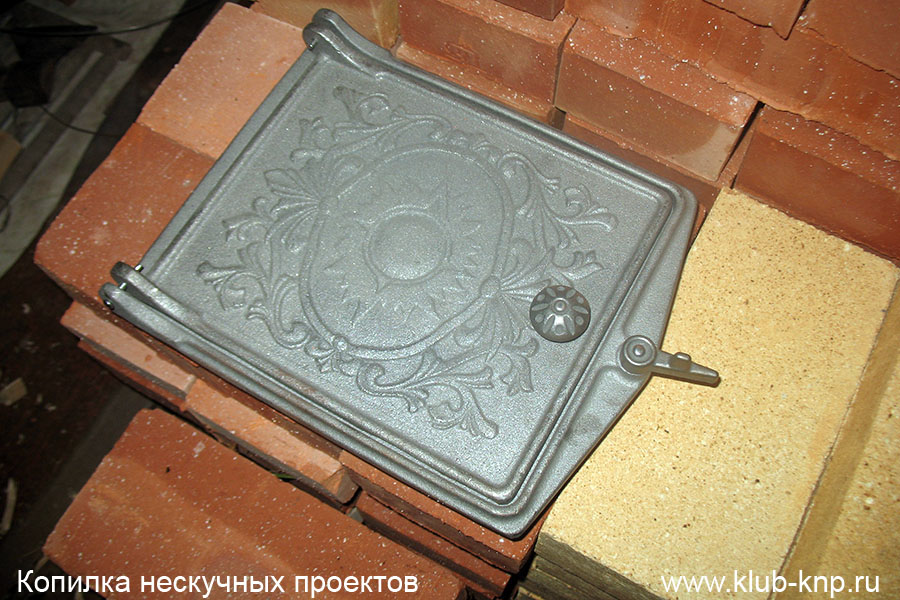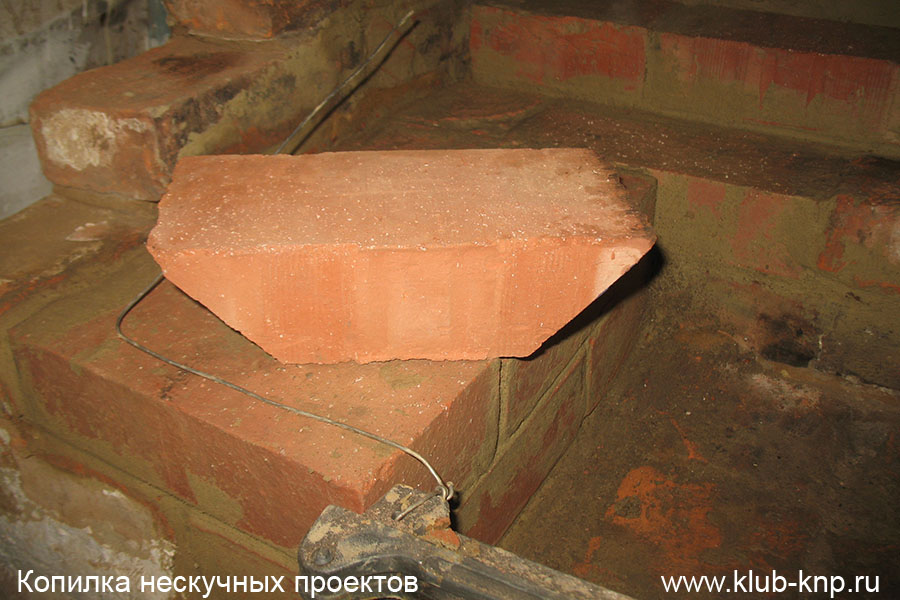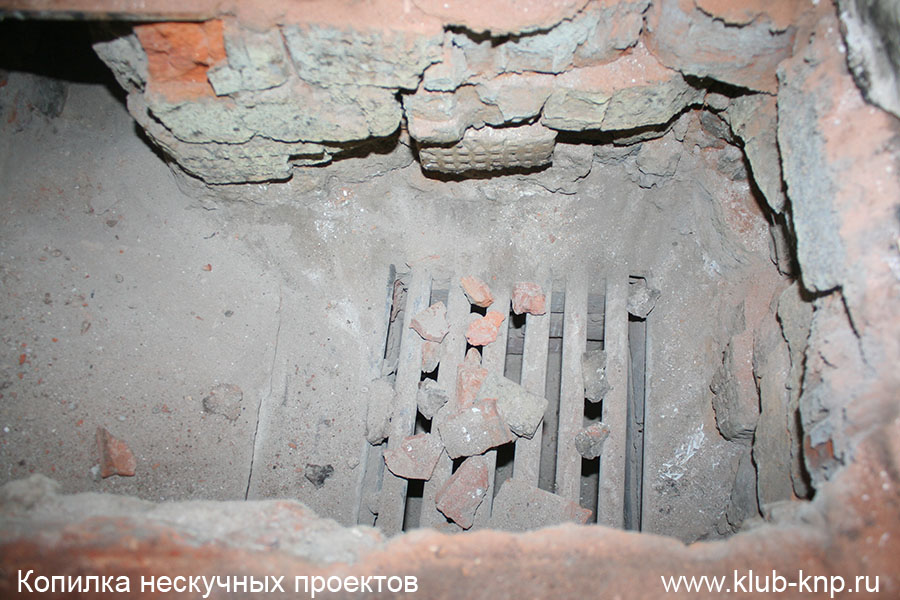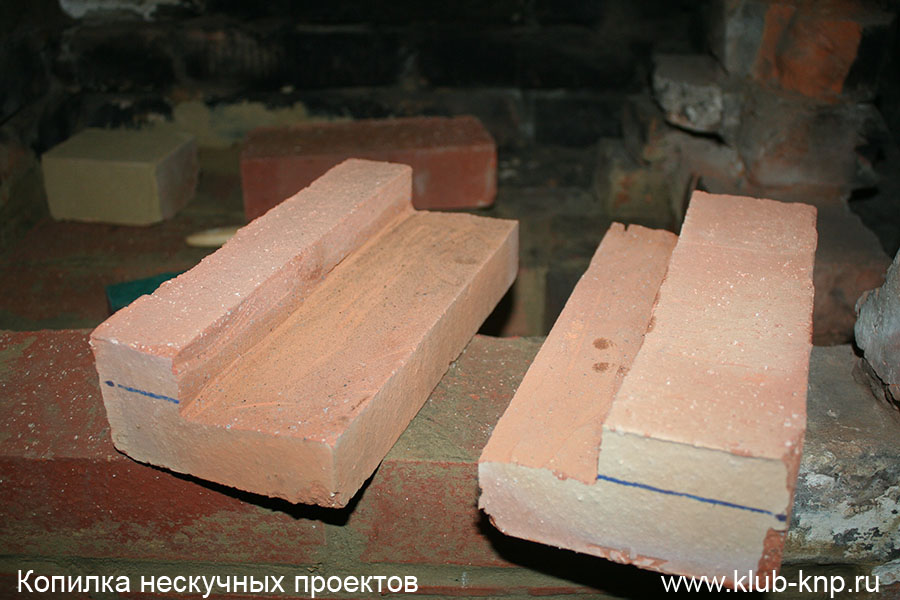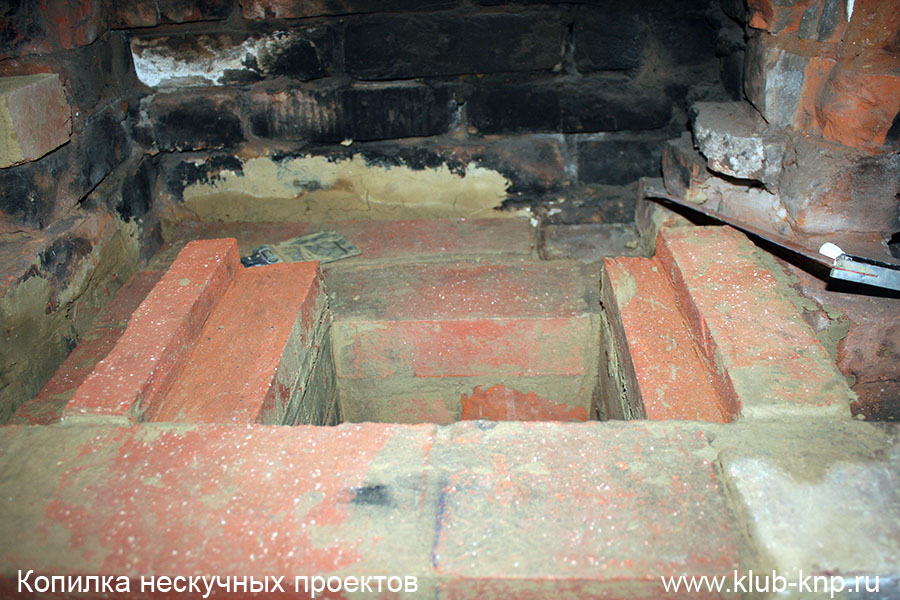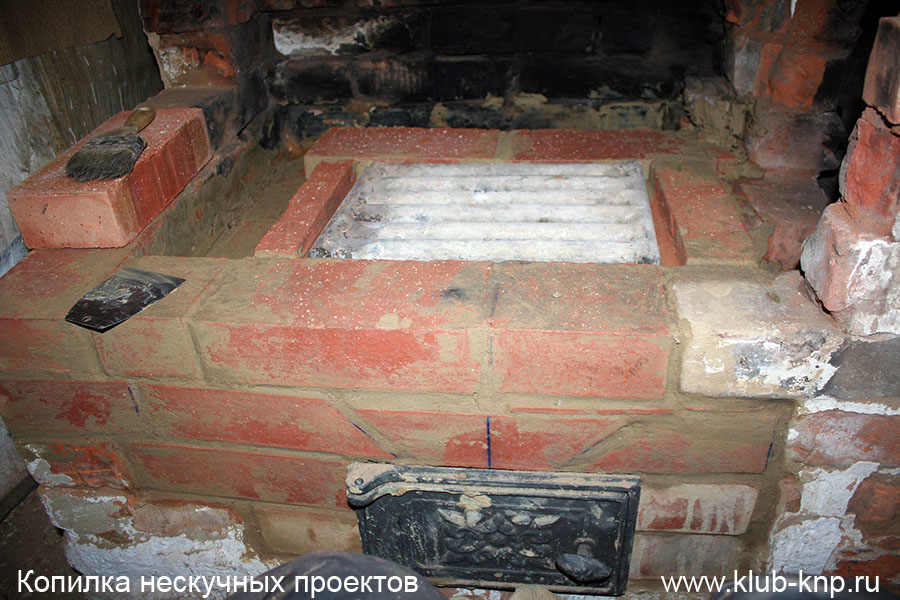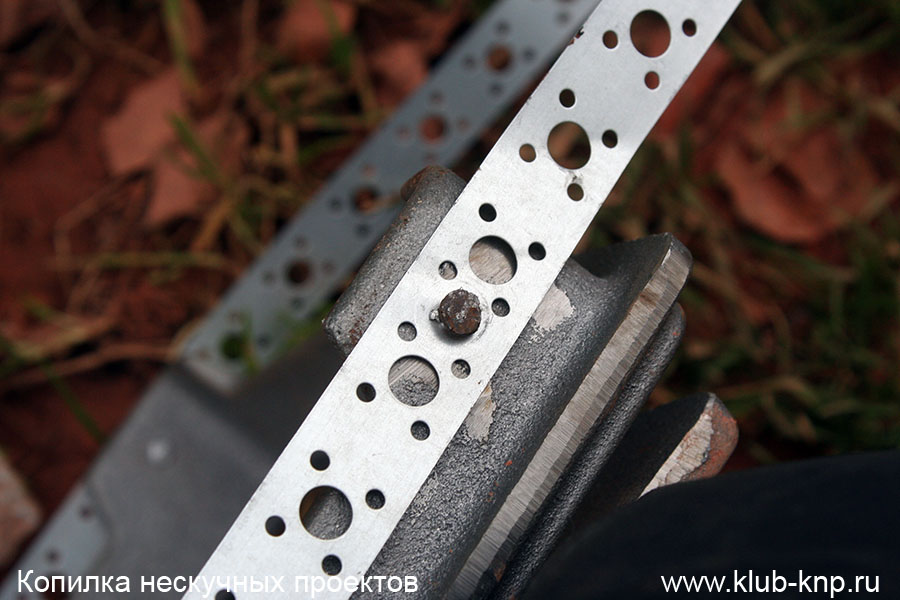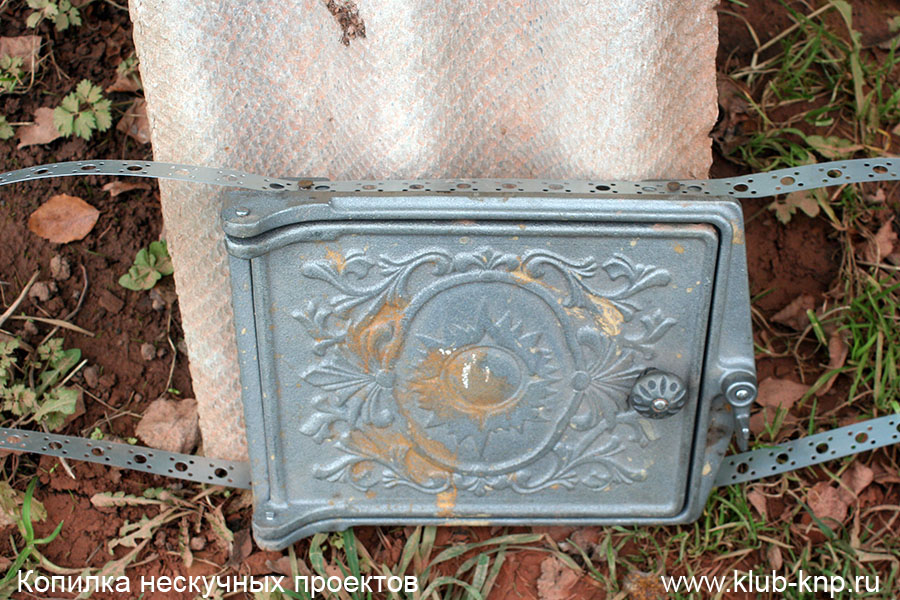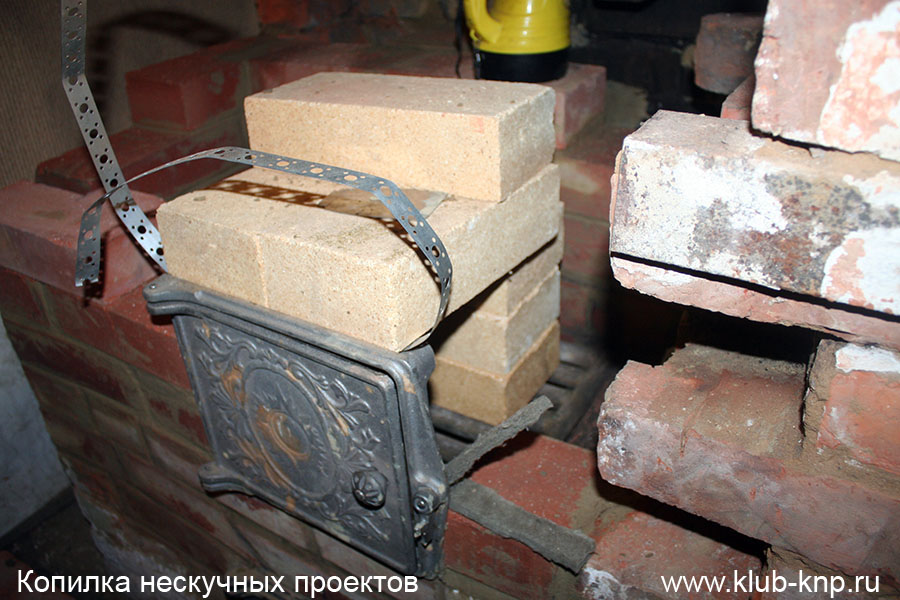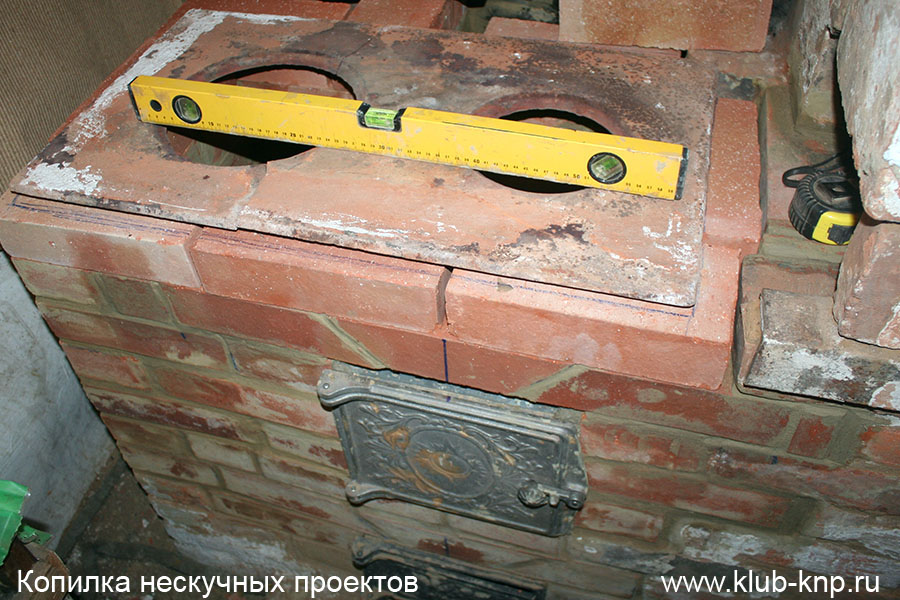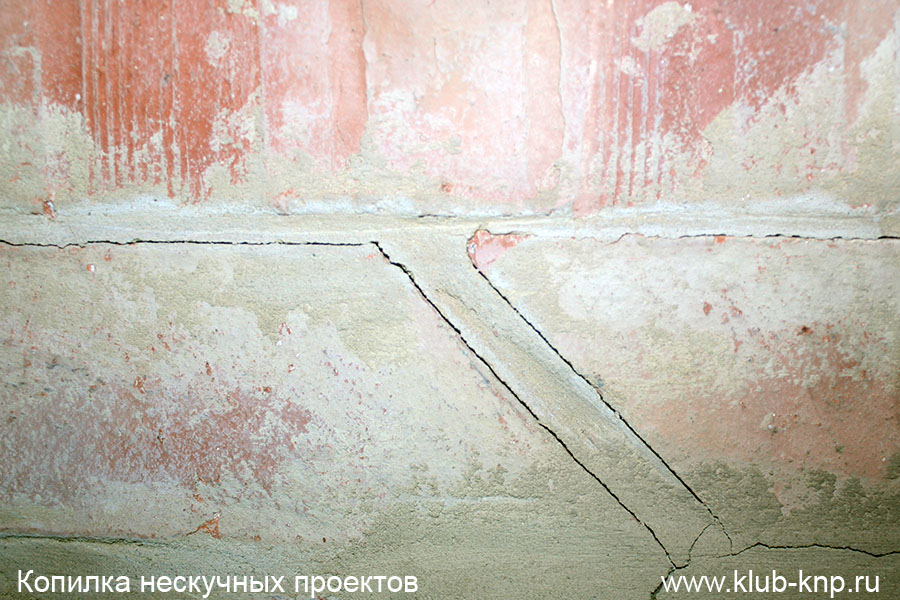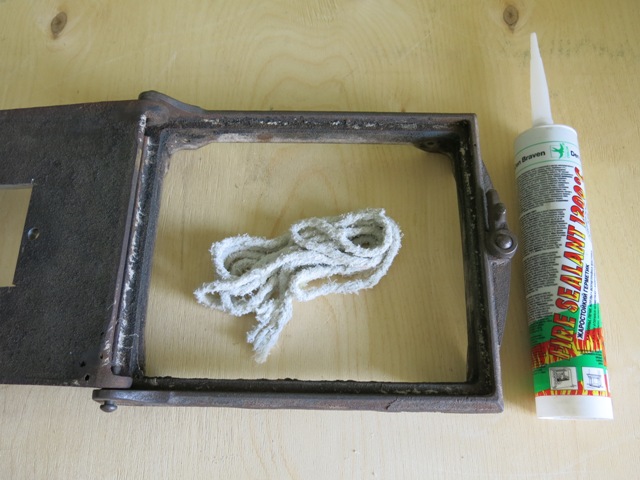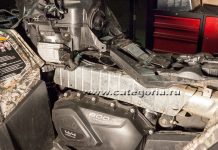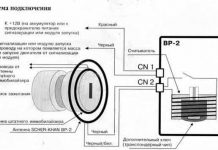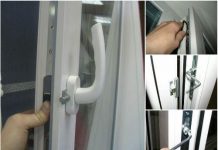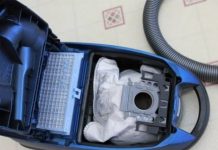In detail: do-it-yourself repair of old ovens from a real master for the site my.housecope.com.
A brick oven can serve for several decades if you regularly engage in preventive maintenance and promptly eliminate damage and breakdowns. Depending on the complexity of the work, it is customary to subdivide furnace repairs into current, average and major. Minor problems are easy to fix in a few hours, while major problems can take days. To save on stove-maker services and extend the life of the stove, it is recommended to make repairs already in the first years of operation.
Professionals strongly recommend that you carefully examine the state of the hearth before the start of each heating season. Timely repair of stoves and fireplaces prevents accidents and fires.
Any owner, even if he does not have building skills, can perform minor repairs to a stove in a country house or in a residential building.
- The scuffs that appear on the pre-heating sheet make cleaning difficult and can cause a fire. The leaking metal must be removed, the floor covering must be protected with an asbestos sheet and roofing steel of the required size must be nailed on top.
- To replace the grate, you need to remove the old part from the oven and clean the area of soot. The new grille must be exactly the same size as the broken one. It is laid in place without mortar, similar to the old grates.
- The chimney should be inspected twice a year for foreign objects and debris. It is recommended to use special chemicals to clean the canals from soot.
Leaky seams spoil the appearance of the brickwork and let harmful gases into the room. To detect weak areas, it is recommended to heat the stove - this will make large cracks visible. To eliminate the problem, it is necessary to clear the seams by 2-3 cm, having previously soaked with water. Next, the walls are well washed with clean water using a brush.
| Video (click to play). |
The resulting depressions are filled with new clay mortar, carefully compacting the mixture and rubbing the voids. To increase the resistance of the mortar to cracking, you can add a little table salt to the clay - 300-350 grams per bucket of mortar. It is recommended to seal wide gaps with a fire-resistant cord. If necessary, the walls are plastered and whitewashed or tiled.
The gaps formed between the doors and the masonry due to mechanical stress and thermal expansion also begin to let dangerous gases into the room. Do-it-yourself oven repair in this case begins with cleaning the surface and removing the old solution. The cleaned area is washed and primed with heat-resistant glue diluted in the same volume of water.
A sealing asbestos or ceramic cord is attached along the perimeter of the door - it protects the clay from cracking, compensating for the differences in thermal expansion of materials. In order not to buy a fake instead of a fire-resistant cord, experienced stove-makers recommend setting fire to the purchase without leaving the checkout. Next, the area around the door is rubbed with repair mortar and left to dry for at least a day.
Similarly, the gaps that appear between the hob and the walls are eliminated. To remove the stove, heat the stove a little, then pry the cast iron with a hard metal object, such as an ax. Instead of a cord in this case, you can use basalt wool or felt. If possible, the old stove can be replaced with a more modern one.
Medium-level malfunctions will also not be difficult to eliminate without the involvement of experts. This approach will help save money on the services of a stove-maker.
Over time, the refractory brick from which the firebox is made collapses and requires attention. Do-it-yourself repair of the furnace firebox is carried out through the furnace door. In the case of minor damage, the destroyed areas are restored using clay mortar or factory-made masonry refractory mixture. If several bricks are damaged, a partial replacement can be dispensed with. To do this, soak and clean the solution in the right place and remove the damaged element. New bricks are carefully inserted into the voids and carefully covered over. It is advisable to take the same composition that was used during construction.
It is not always possible to completely replace the lining through the furnace hole; in some cases it is necessary to disassemble the wall. If the top of the stove is covered by a hob, it is easier to get to the top of the combustion chamber. The new lining is made of fireclay bricks, not forgetting that the refractory material should not be tied up with the one from which the furnace body is folded. In large ovens, bricks are laid flat, in small and medium-sized ones - on the edge.
A new cast-iron door must have the same parameters as a broken one. In order not to be mistaken, you must measure the width and length of the product before purchasing. The old door is dismantled together with the frame, clearing the masonry as much as possible in the right places. So that the masonry mortar can be easily and quickly removed, it is soaked with water. Just in case, you need to stock up on a few bricks - they will be needed if unforeseen destruction occurs during dismantling or unusable bricks are found. Steel legs are attached to the new cast-iron door and set so that the strips are in the masonry seams. An asbestos or ceramic cord must be placed between the masonry and the frame. The gaps are filled with a solution, carefully eliminating all the cracks.
Major renovations are rarely complete without replacing damaged bricks. Most often, the problem occurs above the fire door. The damaged elements are carefully removed from the structure, after soaking the solution, and the resulting "window" is cleaned from the remnants of clay. The new brick is immersed in water for a few minutes and placed on a refractory mortar, after which possible gaps are filled and the seams are rubbed. When repairing a sauna stove, it is recommended to seal large gaps with a mortar with the addition of brick chips made from refractory bricks. The repair of the Russian stove in many cases consists in the restoration of a destroyed or sagging vault. As a rule, to eliminate the destruction, it is required to make a new circle and move the brick in this area. The second vulnerable spot of the Russian stove is underneath, here the burnt-out bricks can be easily removed and replaced with new ones.
For those who do not feel the strength to repair a brick oven with their own hands, we do not recommend taking up work. In this case, as well as if a complex chimney repair is necessary, it is better to immediately seek professional help from experienced stove-makers.
Describe your question in as much detail as possible and our expert will answer it
We bought a house in the village with a stone stove, which turned out to be in rather bad condition. I had absolutely no experience in this matter, so I did not immediately notice that she was “defective”. She was whitewashed and seemed quite decent. I was afraid to undertake its repair myself, but I realized that if you invite a stove-maker, it would cost a very decent amount. In addition, I thought that if I repair it myself, then there will be experience and additional confidence in my abilities. So I started practicing myself - everything worked out for me, and not even bad at all. I will say right away that while the final repair of the furnace is not completed, there are still all sorts of little things to be done in the spring, but it is already working and is working well. So do not be afraid and feel free to take on the independent repair of the brick oven: I think you will succeed too.And now useful information from my experience, how to repair a brick oven with your own hands, both in the country and in a private house.
- Brick. At the construction market I bought a brick of the Tula brick factory, which was called "stove brick". Professionals say that in general there is no special oven brick - any building ceramic brick of any brand will do, even M-75 - the main thing is that it is free of cracks. But, by the way, I really liked the brick that I bought - smooth, without cracks, much better quality than the usual building brick. It cost 15 rubles apiece, and I took as many as 100 pieces. In some stores, they even sell them for 25 rubles apiece. By the way, 7 pieces were not enough, and I had to use the old one, which I took out of the oven. I also bought 20 pieces of fireclay bricks at 49 rubles apiece. Fireclay bricks can withstand very high temperatures, as much as 1800 degrees. I wanted to lining the firebox with them, but then it turned out that it would not work. So this expensive brick lies and waits in the wings - it will come in handy for a new oven.
- Furnace casting. These are latches, furnace and blower doors, cleaning doors, cooking floor. The so-called scar casting (Zavod "Litkom") is the leader in quality. There is also a supplier from Balezino, but the quality there seems to be worse. I took the Rubtsov furnace door, and the ash door, as less important, I bought the Balezin one. I paid 1,500 rubles for everything. I did not consider imported casting: it is, of course, much better quality, but it also costs decent: I thought it was not advisable to buy it. I did not buy a cooking floor (stove): for now I decided to use the old one, which had been split, until spring. I didn't buy the grate either - I used the one that was in the old oven. By the way, it's homemade. Do-it-yourself brick oven repair did not include replacing valves and cleaning doors from me yet, so I did not buy them. I will do all this in the spring.
- Basalt cardboard BVTM used for sealing when installing metal parts: cooking deck, door. I bought two sheets of 5 mm thickness at 156 rubles apiece. This was quite enough and even remained, but I think that it will still come in handy: during the life of the furnace, it may well be required.
- Wire and metal tape. It is used when installing doors. I'll tell you more about this a little later. I found the wire in the garage, and bought the tape in the store (I gave 500 rubles for 20 meters) - the same as in the photo.
- Drill with mixer attachment - used to prepare the solution.
- Brush (drill attachment) - used to remove soot and old mortar from bricks in some places.
- Grinder + disc for metal + metal disc for concrete - mainly used to cut bricks. It turns out quickly, evenly, but hefty dusty, so buy another respirator. Sometimes it was required to cut the metal too: now a corner of some of the oven sticks out - I cut it off completely, then the grate cut. The photo shows an example of using a grinder when working with bricks. This is a key brick, which is placed over the firebox door.
- Building level - it is clear why.
- Gon - it is better if it is long, I had a short one. I mainly used it to mark out bricks.
- Roulette - for measurements of all kinds.
- Marker - they marked the brick. I took the marker from my daughters from drawing sets and will not return it, because it has worn out in the trash.
- Trowel, trowel - used to work with the solution. Basically I used a 70 mm wide spatula, it seemed to me that it is more convenient for them to work than with a trowel.
- Hacksaw for wood (old) - used to cut a brick out of the oven at the seam. An irreplaceable thing. Sometimes it was required to take something smaller, then I used canvas for metal.
- Hammer - used to neatly straighten a newly laid brick. And so, for other purposes, the hammer will find application.
- Sponge for washing dishes - wetted the surfaces of bricks prepared for mortar with water.
- Buckets - for mortar and for soaking bricks in water.
- If non-critical cracks need to be repaired, then, of course, it is not necessary to disassemble the oven. We melt it - the seams expand. Then we thoroughly clean out the old mortar until we clean the brick well at the crack. It is convenient to work with a cloth for metal.
- If a cracked brick needs to be replaced, then an old wood saw comes to the rescue for cutting bricks from masonry along the seam. Then carefully remove the brick and clean the bricks in the masonry, preparing them for mortar.
- If most of the oven is in critical condition, then you have to take out a lot of bricks. It is very dusty. I did not think of separating the stove from the room with foil, and my whole house was covered with a layer of dust. We remove the bricks until we reach those that hold tight. But turn on your head, otherwise you can disassemble the whole stove. The fact is that some bricks that wobble a little can be left in the masonry. Then they will bond with their new neighbors, and everything will be fine. And, of course, we also take out all the cracked bricks, and also the burnt ones. Here, look at the photo of how my firebox looked like. She had to take it all apart and put it all over again. I took out about a little over 100 bricks from the entire oven.
After you have prepared the seams for repair (I wrote about this above), we wet the bricks with water using a sponge and put the mortar into the seam: we take it a little bit and with a trowel we "chase" the seam - we seal it with the edge of the trowel until the metal practically stops penetrating into the solution.
Do-it-yourself brick stove repair is very often a furnace repair. First of all, I took out all the burnt bricks and prepared the firebox for new masonry. But there was one serious problem: one of the walls of the furnace turned out to be load-bearing in the entire structure - let's say, the pipe rested on it. Therefore, I decided not to remove the bricks from this wall, but simply shifted the firebox to a half-brick to the side and laid out a completely new firebox wall. There is nothing particularly difficult in the masonry itself - just do everything carefully, take your time and try to keep all the bricks tied. Under the grate, I cut out the bricks with a grinder so that it would lie in the grooves, as it were. The grate must lie freely under its own weight with a gap of 5 mm from the bricks, otherwise it will expand from heating and begin to destroy the masonry. Some people advise to fill these free gaps with sand, but I did not - they themselves will fill with ash.
All kinds of doors (furnace, blower, cleaning) are installed so that there is a gap of 5 mm between them and the bricks, otherwise they will destroy the masonry when heated. The doors are fastened either to wire or to tape. They are attached to the wire like this: four pieces of wire are tied to the door (there are special holes in the doors), and then these mustaches are embedded in the masonry. Places for embedding (seams) must be pre-cleaned. If the door wobbles a little after the mortar to be laid has dried, then bend the wire with pliers - as if pulling it. In this way, I fixed the blower door. I did not like this method - the door is not very securely mounted in the masonry.
But the fire door, as a more responsible one, I fastened with a metal tape. I riveted two strips to the door with rivets, which I made from cut nails, and walled up this whole structure in the masonry. It turned out perfect. Therefore, I almost forgot about the basalt sealant, which is placed between the metal of the doors and the bricks. You can immediately close it up, and then you can fill it in a 5 mm gap.
The cooking deck was also installed with side gaps from bricks of 5 mm. It lies with me just under its own weight, but along the perimeter under it there is a basalt sealant in two layers.So that the cooking floor was flush with the plane of the stove, I cut out grooves in the bricks with a grinder along the perimeter of the stove.
This time, he did not repair the valve on the pipe and the cleaning doors for soot - he postponed this business until spring. But the general approach is the same.
Ideally, if the oven dries up by itself. This is long enough: it can take a month or two. Drying times will depend on the scale of the repairs performed. Another drying option is with gentle heating. In this case, it is important not to overdo it, otherwise the seams will crack. This is exactly what happened to me: the upper two rows of the stove, newly laid out, cracked at the seams, because I hurried and went out ahead of time (5-7 days) to the normal mode of the furnace.
In my case, this is not critical: in the spring I will move the heels of the bricks again, and in some places I will simply rub the cracks. But nevertheless, it is still unpleasant. And one more thing: the criterion that the stove is dry is that there is no condensation (water droplets) on the cleaning doors and on the valves.
If the Russian stove is used incorrectly or for a long time, certain problems may arise that require the intervention of the owner. In this case, it is not necessary to call a stove-maker; you can carry out repair work with your own hands, without the involvement of specialists. This article will tell you about various problems and ways to solve them.
If you notice that the heating system has begun to function incorrectly, then you should carry out a step-by-step solution to the problems. This must be done in a timely manner so that the structure is not damaged, and the operation is without negative impact on the atmosphere in the room. Let's figure out how to quickly repair the frequently occurring problems of the Russian stove, which is also called current, since it is necessary all the time.
The draft inside the chimney may disappear precisely due to insufficient maintenance of the furnace structure. To prevent this problem from ancient times, aspen firewood has been used for heating, which helps to clean the chimney. Heat the stove with aspen chips, make sure that the smoke coming out of the chimney changes color from black to light gray.
Try using aspen firewood
The formation of soot inside the chimney occurs due to the use of low-quality raw materials when firing in the furnace. Garbage incinerated in the structure carries the greatest danger, therefore it is strictly forbidden to use it as fuel. Heating with raw wood can also lead to the formation of a large amount of soot.
You can clean a brick oven through a special metal door, or using a special device through the chimney pipe on the roof of the building, which is presented in the form of a long cable with a heavy load and a brush at the end.
Use a cable to clean the chimney
Due to the appearance of cracks and cracks in the furnace structure, serious problems may arise during its operation:
- Cold air enters through the holes and the efficiency of the heating system is significantly reduced;
- The release of carbon monoxide from the holes is possible, which can cause poisoning and suffocation of those in the room;
- Small cracks can expand and if they are not eliminated in a timely manner, then a major overhaul of the structure will be required.
But on the building materials market today you can buy a special solution for brick stoves and fireplaces, which is used to cover up the holes that have appeared. The most popular are: "TerraKot", "Pechnik", "Parade". The correct consistencies are indicated on the packaging.
If visually visible damage has appeared in the furnace structure in the form of cracks, breaks, cracks or other holes, then you should not panic - these problems can be easily solved without calling specialists. Purchase a spatula and a special compound intended for the repair of fireplaces and brick stoves in advance, then you can proceed with the current repair of the heating system structure.
- Clean the appeared damage from dust;
- Prepare a solution of the desired consistency from the purchased mixture, in a small amount so that the excess solution does not harden;
- Using a spatula, seal the previously cleaned cracks;
- Allow the solution to dry; for visual beauty, the places of the repair work carried out can be treated with whitewash or special paint.
Under strong mechanical loads and high temperatures, between the masonry and the fire door, or the hob, gaps may appear, which lead to gases hazardous to human health entering the room. To eliminate this problem, it is necessary to seal the furnace door or hob with a special cord and repair mortar. All this can be purchased at a hardware store.
The Russian stove is a unique structure, one of the features of which can be considered a possible independent repair, without the involvement of a stove-maker, whose services are quite expensive. Sealing the holes between the masonry of the fire door and the hob is one of the easiest jobs to implement:
- Clean the area between the metal element and the masonry, from dust and dirt;
- Wash the gap, prime and process with heat-resistant oven glue;
- Purchase a specialized fireproof cord in advance;
- Insert the cord into the hole between the masonry and the fire door or hob - it will compensate for temperature changes and protect the solution from cracking;
- After that, rub the hole with the repair mortar using a spatula;
- Let the composition dry for at least a day.
You can save on the services of a stove-maker not only during routine repairs, but also when carrying out major work to eliminate serious problems. Including with your own hands, you can re-lay the firebox, replace the firebox, restore the masonry and solve other problems. In this case, only a specialized solution and refractory materials should be used in order to prevent the appearance of additional problems during the operation of a Russian brick oven.
Despite the properties of refractory bricks, over time, it becomes unusable, therefore, timely replacement of this component of the structure is also necessary. Do-it-yourself re-laying of the firebox is a rather complicated process and is often trusted by a professional stove-maker, but in order to save money, the overhaul of the stove can be carried out on your own.
If a small damage is detected in several bricks in the structure, then a complete relocation of the furnace can be omitted, having made only a partial replacement. For this purpose, remove the damaged parts in the masonry and after cleaning the surfaces, using a special solution, make a new masonry.
Relining of the lining is one of the most common types of overhaul. In its production, only fireclay bricks are used. It should be remembered that the refractory masonry must not come into contact with the brickwork of the furnace body.
In order not to reduce the overall efficiency of the structure, you should purchase new parts with the same parameters and dimensions as the old ones. This also applies to the fire door, which is most often made of cast iron material. When buying a door, measure the old one and when purchasing a new one, correlate them in size. Also remember about the need to use exclusively specialized solution for fireplaces and stoves.
Dismantle the old part together with the frame, clearing as much space as possible for the new door. Then you can start replacing it:
- Clean the old mortar from the masonry;
- Attach the steel tabs to the new cast iron piece and position it so that the strips are inside the masonry joint;
- Between the oven masonry and the door frame, a pre-purchased cord with fire-resistant properties should be laid;
- All gaps are filled with a special solution;
- The composition is allowed to dry for 1-2 days.
In a Russian oven, frame brickwork is rarely damaged, since by itself it does not come into contact with fire and does not threaten damage due to temperature extremes. But if the stove-maker has done the wrong repair work, then it can be damaged too. The restoration of the frame is a simple type of repair, it does not require specific skills or specialized materials.
Due to the fact that the repair of a Russian stove with your own hands is not difficult, whether it be current or major work, the elimination of problems can be carried out without the involvement of a professional stove-maker, which saves money. The main thing is not to forget about their timely implementation and high-quality cleaning of the stove, so that the problems that appear do not lead to more serious damage to the structure.
A well-built stove in a country house or in a country house can serve for decades, warming up with its warmth, if preventive examinations are carried out in a timely manner, eliminating emerging problems and not postponing their solution until later.
Timely repair of an old furnace with your own hands will significantly extend its service life and save you from additional costs.
This is what the old stove looks like after repair - the brickwork and hob, top and bottom doors have been replaced
To avoid accelerated failure of the furnace, you should familiarize yourself with the rules for its safe operation - this will help to quickly cope with emerging malfunctions.
Like any equipment, the furnace needs periodic inspections, current, medium and major repairs. The complexity of the upcoming repair depends on how serious the internal and external damage is. Due to the special climatic conditions, the stove must be heated most of the year, especially if it is used for cooking. Therefore, the frequency of inspections is an important component of the quality and safe use of the oven.
To prevent the occurrence of fires, fires, carbon monoxide poisoning, it is necessary to repair the old stove in time before the start of the heating season. Before that, conduct a complete examination of all components, carefully checking the condition:
- metal flooring in front of the firebox;
- base and walls;
- furnaces, including the reliability of the lower and upper doors, grate, ash pan;
- cooking stove;
- chimney;
- stove damper used to adjust the draft in the stove and in the chimney;
- condition of masonry and masonry seams.
We advise you to read an article about choosing a brick for laying a stove and add the article to your bookmarks.
Video: DIY brick oven repair
Important: The detected faults and blockages should be eliminated before the start of the heating season - this will help to avoid problems during the operation of the stove.
The correct design and operation of the chimney is the cornerstone of the safe operation of the stove. The chimney must be free from accumulations of soot, debris, pieces of crumbling clay and bricks, and foreign random objects - this is necessary for the free passage of waste air streams containing smoke and other combustion products.
Installation diagram of a stove with a chimney passing through the floor slabs and the roof, with a thermal insulation device
Important: It is recommended to clean the chimney channels at least 2 times a year.
Special tools are used for cleaning:
- telescopic (sliding) brushes specially designed for this purpose;
- special vacuum cleaners with which you can remove soot, however, vacuum cleaners are ineffective for large blockages;
- dry cleaning using liquid or powder products, the application of which to hot surfaces leads to the separation of soot accumulations.
All these chimney cleaning products require some skill, so it is better to entrust such a responsible job to professionals.
Chimney cleaning using a special tool - brushes with a telescopic extension
Attention: The cleanliness of the smoke exhaust system of the stove is especially important for the complete removal of carbon monoxide (CO) from the furnace, which is formed in the event of incomplete combustion of fuel, its presence in the air in an amount of 0.1% CO is fatal to human health.
When checking the technical condition of the chimney, you should pay attention to the quality of the chimney thermal insulation in the places where it passes through the ceiling and roof ceilings - damage to the insulation layers can lead to overheating of the floor material and its fire.
If, during the inspection of the chimney, internal and external cracks, chips, cracking, etc. are found, repair of the chimney channels will be required, which is significantly complicated due to the considerable length and small cross-section of the chimney.
Repair and strengthening of the chimney with external lining with artificial stone
Depending on the volume of destruction, it may be necessary to:
- In the dismantling of the chimney with the subsequent restoration of brickwork (with the destruction of more than 20%).
- In partial replacement - damaged knocked-out bricks are removed, new ones are laid in a pre-cleaned place, in a mortar (in the proportion: 1 part cement, 0.5 part lime, 2.5 parts sand). For greater strength, additional lining of the chimney can be made (Fig. 4).
- In the installation of sleeves in the smoke ducts. This method is the most promising - steel or ceramic pipes (sleeves) installed inside the old chimney are easily cleaned of soot, are not subject to cracking and chips, which greatly facilitates the operation of the chimney.
- Internal lining - performed if cracks appear on the surface of the chimney walls.
When inspecting an old furnace, the following defects are most often found:
- Damage to seams and cracks in masonry, which are better visible if the oven is preheated. As a result of damaged masonry and large cracks, it is possible for flue gases to enter the room - it will be necessary to seal the cracks (Fig. 5).
Repair of brickwork with preliminary cleaning and subsequent filling of the joints with cement mortar
- To restore the normal functioning of the furnace, the seams are pre-soaked with water, cleaned to a depth of 2-3 cm and additionally moistened, after which they should be tightly filled with clay mortar. It is recommended to add table salt to the clay mortar (0.5 kg per bucket of mortar) - this will prevent the joints from cracking. Strengthening the frame of the brickwork can be done by covering it with ceramic refractory tiles.
- The appearance of rust on the metal flooring in front of the firebox - the thinned flooring should also be replaced by placing an asbestos sheet under it.
- Loosening and loosening of the frame of the firebox door and the blower door, gaps between the hob and the brickwork of the stove, resulting from thermal and mechanical effects. Stove repairs will also be needed here in the places of their contact with the brickwork, which must be cleared by removing the old mortar. After rinsing, heat-resistant glue is applied to the cleaned areas, diluted with water in a ratio of 1: 1. An asbestos or ceramic cord must be placed between the brickwork and the frame, the gaps must be completely filled with mortar (Fig. 6).
Installation and strengthening of oven doors using ceramic cord and cement mortar
- To secure the hob, it must first be removed - it is easier to do this with a hot stove, prying it with a crowbar or ax (Fig. 7). After that, in the same way as in point 4, prepare the surfaces by sealing the places for laying with basalt felt.
Removing the old hob after preheating the oven
The opinion that stove heating remained only in the villages is nothing more than a stereotype.The owners of new houses and cottages often use this type of heating. Folding a new stove is only half the battle; you still need to be able to take care of it and, if necessary, make current repairs. During long-term operation, a number of problems may arise, which can be solved either by a specialist, or, using some advice, you yourself.
Regular preventive measures can help prevent serious damage to your brick oven.
The main sign that your stove needs immediate repair is insufficient draft, when smoke, instead of going outside, ends up in the room.
This is not only unaesthetic, but also extremely dangerous, as it can cause burnout.
What are the reasons why the stoves start to smoke? Firstly, it can be a consequence of the deposition of a large amount of soot in the chimney. Therefore, always after the end of the heating season, it is necessary to clean all outlets and pipes from excess deposits. Secondly, thin masonry walls can remind of themselves. From extreme cold they can freeze or damp, from which the passing gases are cooled. Cracks and crevices may also form, through which smoke seeps into the interior of the room.
Do-it-yourself routine repairs can be started by preparing the necessary materials and tools:
- clay;
- sand;
- water;
- a sieve for filtering clay;
- bonding materials: cement, asbestos;
- heat-resistant glue;
- ceramic heat-resistant cord for the oven;
- masonry tools.
Stages of removing the old whitewash: a - moistening with a roller; b - removal of the whitewash layer with a spatula.
For stoves, you must use a clay solution. It is perfect not only for cleaning cracks, but also for laying bricks. The proportions of the solution should be read as follows. Depending on the fat content of the clay, for 1 volume of it there are 1-3 volumes of sand, you will also need water.
A day before starting work, the clay must be soaked, then add as much water until a consistency similar to a creamy mass is obtained. All light impurities will float up, so the solution must be filtered through a special sieve. Only then can sand be added to the clay and stirred until all the puddles disappear.
You should not add the entire volume of sand at once, it is better to add it in small portions. A good oven solution should not crack in the end.
Since the plaster must withstand constant temperature fluctuations, the mortar must be strong and resistant to cracking. For plaster, the following are most often used:
- lime-clay;
- lime-gypsum;
- cement-clay-sand mortars.
Additional materials must be added to any type of mixture: fiberglass, foam, asbestos or straw. There is no consensus on salt, so its use is down to personal discretion.
To begin with, the cracks must be cleared 20-40 mm in depth and all the old mortar must be removed. After that, the cleaned surface must be moistened with plenty of water. To clean the cracks, salt and asbestos powder must be added to the clay solution in small portions, after which all the holes must be carefully rubbed with the resulting mixture.
Before laying a new brick, the cracked one must be removed from the seat and the place for the mortar must be cleared. The new brick must correspond to the size, otherwise after a while it will also need to be changed. The place of masonry and the new brick must be moistened with plenty of water, then spread with a clay mortar and put in place.
Most of the cracks occur near the stove door. In order to compensate for the expansion of the cast iron fittings, a sealant is used - a ceramic heat-resistant cord. Feel free to check its quality in the store to avoid being counterfeited.
The area around the fittings must be cleaned and washed with a mixture of water and heat-resistant glue (1: 1).After that, you need to lay the cord around the perimeter and treat it with a solution, adding a small amount of heat-resistant glue or cement to it in advance.
If you have problems finding such a cord, you can replace it with basalt or felt.


